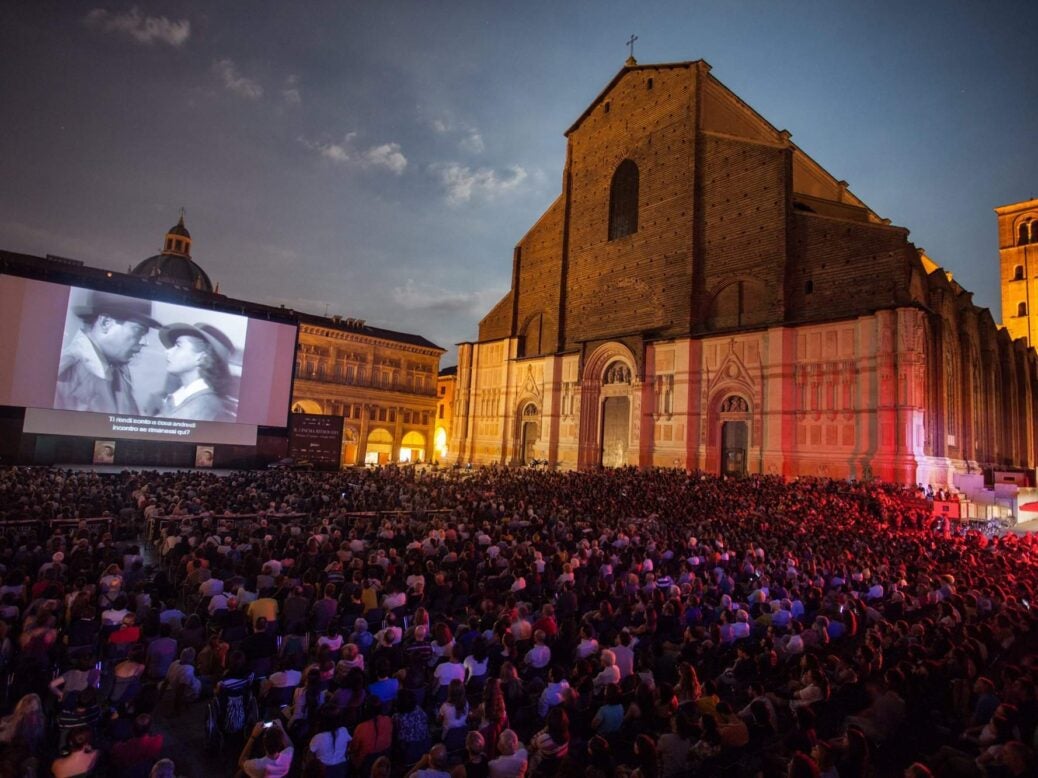
The Italian city’s famous history is delightfully complemented by its state-of-the-art hotels, says Christopher Silvester
Bologna, the site of the world’s oldest university, is often overlooked by tourists, but it has much to recommend it. You fly in across the city’s reddish-orange rooftops and land at a modest little airport that is a mere twenty-minute ride from the city centre. Once there, you can walk across the old city, in any direction, in about twenty minutes. It is known as the city of porticos — 25 miles of arcaded streets — so there is plenty of shade to shield you from the fierce summer sun, though the humidity is nonetheless a challenge. Summer temperatures can be as high as 36 degrees, which is similar to Dubai.
I am here in the last week of June for an annual film festival called Il Cinema Ritrovato, which shows rediscovered and restored 20th-century films, all with English subtitles except those which were originally made in English, which have Italian subtitles.
The free screenings in the Piazza Maggiore each night, shown to an audience of several hundred, are a delight. I saw Jacques Becker’s Casque d’Or (1952) on one night and on the following night I saw the classic Fred Astaire musical The Band Wagon (1953). You just have to hope it’s not too humid. During the daytime, the festival shows classics in a couple of cinemas, one of them with more effective air conditioning than the other.
Bologna’s two best hotels, the Grand Hotel Majestic ‘Già Baglioni’ and I Portici Hotel Bologna, are both located on the city’s main street, Via dell’Indipendenza. The former is a five-star hotel and one of the Leading Hotels of the World, while the latter is actually a four-star, though its rooms are spacious and luxurious in a pared-back, contemporary style.
The Grand Hotel Majestic was opened by Torinese industrialist Guido Baglioni in 1912, in two connected buildings, the former Palazzo Ghisilardi Fava (a 15th-century building) and the former episcopal seminary building and residence (an 18th-century building) opposite the duomo, the Cathedral of San Pietro. Although 30 per cent of the hotel was destroyed by dynamite saboteurs in the Second World War, the structure was restored to its former glory by 1948 and remains the pre-eminent hotel in the city, an example of thoughtfully updated Belle Époque splendour.
In the mid-1960s, the Baglioni family sold the building and moved to Rome. The hotel remained closed for 25 years, reopening in 1987 after a complete renovation. The Polito family, the new owners, kept the name, but in 2010 they decided to invest more in businesses outside Italy and sold it on to the Duetorrihotels Group, which also owns hotels in Florence, Verona, and Genoa. There followed a period of major structural renovations, with every bathroom from the first to the fourth floor being improved to the highest standard.
There are 109 rooms in total. There used to be 124, but the owners decided to create more junior suites on the fourth floor by combining rooms. There are now thirteen suites and junior suites, and half a dozen executive suites, as well as three ‘presidential’ suites, one of which is located on the top floor with a roof terrace and a panoramic view of the city. In the last five years, the hotel has been seeking a luxury clientele.
In the city’s collective memory, the Majestic was an important meeting point in the 1950s and ’60s, and the hotel’s bar, the Cafe’ Marinetti, contains original photos of the hotel’s celebrity guests, such as Maria Callas, Sophia Loren, Frank Sinatra, Clark Gable, Diana, Princess of Wales, Luciano Pavarotti, Federico Fellini, and Sting. Cafe’ Marinetti is named after the Italian Futurist artist Marinetti, who used to drink here, and the Roberta cocktail is named after one of his paramours. The new owners have given this bar a more contemporary atmosphere by installing a Carrara marble floor.
For old-fashioned intimate dining, the Majestic has the historical I Carracci restaurant, so called because of its beautiful frescoes of the school of the Carracci brothers depicting an allegory of the four seasons. Similar 16th-century frescoes adorn the walls immediately below the coffered ceiling of the Camerino di Europa, now a formal meeting room. There are only sixteen tables in the restaurant, with the space between them allowing for proper service and attention as well as affording intimacy to the diners.
Bologna has an ancient tradition of cellar restaurants and in the Middle Ages every church had its own cellar for wine. These became osterie and trattorias, and later restaurants. Since the Buca San Pietro — buca means hole — no longer complied with EU law, the Baglioni family renovated the Majestic’s cellar to create a private dining area and chef’s table experience, known as the Morandi Wine Shop, where you are surrounded by bottles of wine, with a private maître d’ to look after you. This dining area in the temperature-controlled cellar can take a maximum of 26, though twenty is the recommended number.
There are reception rooms for weddings and parties, with food provided by new executive chef Claudio Sordi, who earned three Michelin forks in 2016. The hotel serves modern Italian, traditional Bolognese, and international dishes.
Since the Majestic is a listed building, there is no pool and no full-scale spa. However, there is a fitness area, a gym, and a health and wellness centre containing a Turkish bath and sauna.
The hotel’s larger suites are frequently occupied. In the 1990s, the hotel had more single or double rooms, but different guests are now coming to discover Bologna and the region of Emilia-Romagna. Since the eurozone crisis, the city council has invested a great deal in tourism, and the region has been promoting its globally recognised products, such as Parmesan cheese, Parma ham, balsamic vinegar, and wine. Tourists also come to visit the nearby automotive museums. Another attraction is that you can reach Florence by train in 35 minutes: sleep in peaceful Bologna and visit the bustle of Florence by day. Bologna is a lively city, but it is compact, not especially crowded, and safe to stroll around. There is usually a decent exhibition in town — there was one of Edward Hopper paintings while I was there.
The Giambologna Presidential Suite (dedicated to the Flemish sculptor Giambologna, who created Bologna’s Fountain of Neptune) is furnished in Venetian style and has two bathrooms. This includes the Lady Diana Room, named after its most famous guest, though Maestro Rostropovich, the famous cellist, liked the same room, often rehearsing and meeting students there while he was in town.
The Giuseppe Verdi Presidential Suite has one bedroom, while the Giuseppe Verdi Royal Suite has two bedrooms, with the main one containing an elaborately carved antique wooden bed from Barocco and heavy curtains of damask velvet and silk brocade. (If these two suites are booked together, there is a master door to the hallway outside so that it can in effect become an apartment.) An English royal stayed there in May of last year, followed a week later by the Imperial Prince and Princess of Japan.
The Art Deco terrace suite has a bedroom with a fine and highly polished wooden parquet floor, a stylish living room, and a panoramic roof terrace that looks straight across the street to the top of the cathedral and across the skyline of Bologna, since very few buildings are higher than this.
Wandering out of the hotel into Via dell’Indipendenza, you will find that the porticos on either side contain Bologna’s prime shopping spaces, including the Italian designer and international brands. At the top of Via dell’Indipendenza, close to the railway station, is I Portici Hotel Bologna, which is a wonderfully modern reimagining of a traditional building, formerly a single palazzo residence, the Maccaferri Palace. ‘Modern’ rooms are decorated in a minimalist style, while ‘Liberty’ rooms are decorated in a more traditional way with furnishings that hark back to the Belle Époque. They overlook Via dell’Indipendenza at the front of the building and Pincio Park (also known as the Maccaferri Palace Winter Garden) at the back. The park is elevated from street level and reached by grand staircases that curve upwards in two directions.
The theatre, formerly a famous café, can be used for events, but also serves as the hotel’s breakfast room. The Sala di Feste, a ballroom on the first floor, can take 200 people.
In the hotel’s basement is the Ghiacciaia (meaning ice house) of La Rocca di Galliera. In the old cellar, where they used to store ice in the hot summers before refrigeration existed, the owners have created a private dining room that seats 30, its glass floors allowing one to look down into the hotel’s wine cellar below.
I Portici has 89 rooms and three suites. All the rooms are airy with remarkably high ceilings, almost three metres high, sometimes more.
On the fifth floor of the ancient palace, or Imperial floor — really the attic — the three spacious suites are examples of modern minimalism with an abundance of white. Suite 5.50 (50 square metres) has one bedroom and a studio, while Suite 5.80 (80 square metres) has two bedrooms and a studio. The hotel used a Bolognese designer called Lanzi for its suites and all items of furniture are modern designer pieces.
At 160 square metres, I Portici’s Imperial Suite is the largest suite in the city. It has two bedrooms, two bathrooms, a living room with a view of Pincio Park, a dining area, and a studio. As with the Majestic’s Art Deco suite, it has a magnificent roof terrace from which you can look across the rooftops. Today, Bologna has virtually no buildings higher than this apart from a couple of medieval towers, but back in the 12th century it boasted as many as 180 towers, all thrown up by status-conscious Bolognese in an unregulated fashion. From I Portici’s roof terrace you can see the porticoed route climbing a distant hill to the Basilica Santuario di San Luca.
The region is the birthplace of global automotive businesses such as Ferrari, Ducati, and Lamborghini, all based in what is called Motor Valley. Bologna itself is the headquarters of industrial machine manufacturers such as Coesia, owned by the Seràgnoli family, and G.D., which owns 58 factories worldwide and makes cigarette packaging machines for the tobacco multinational Philip Morris. Here, the wealthy families are low-key, and its leading hotels, while undoubtedly luxurious, reflect this.
Bologna is a city that is known for its hospitality, cosmopolitanism, and open-mindedness, but also for its proud industrial heritage. If you are interested in industrial archaeology as well as medieval and Renaissance buildings, or in the hydraulic system of underground canals that drove the city’s medieval textile mills, there are rewarding tours available. Best of all, you are never far from somewhere to have an excellent meal, and if you yearn
for gelati or granite then your prayers will be answered unfailingly.
FACTBOX
Grand Hotel Majestic ‘Già Baglioni’
Grandhotelmajestic.duetorrihotels.com
Tel: +39 051 225445
Junior suites start at €650 for single occupancy.
One-bedroom suites start at €940 for single occupancy.
Presidential suites start at €1,240, again for single occupancy.
I Portici Hotel Bologna
iporticihotel.com
Tel +39 051 42185
Suite 5.50: €200 to €500 for double occupancy.
Suite 5.80: €300 to €600 for double occupancy.
Imperial Suite: €400 to €900 for double occupancy.














